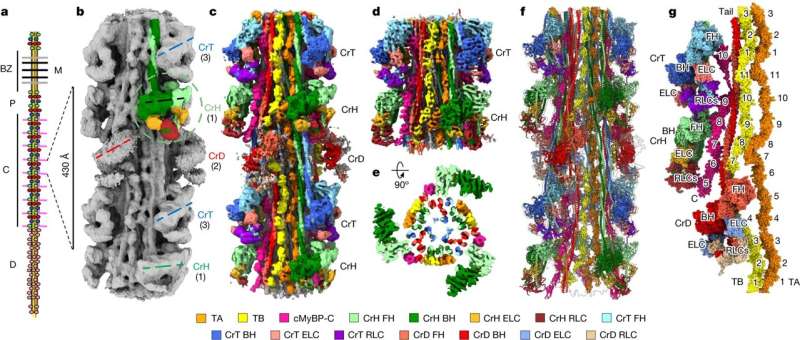This article has been reviewed according to Science X's editorial process and policies. Editors have highlighted the following attributes while ensuring the content's credibility:
fact-checked
peer-reviewed publication
trusted source
proofread
Researcher helps solve 60-year mystery inside heart

One University of Kentucky (UK) researcher has helped solve a 60-year-old mystery about one of the body's most vital organs: The heart.
Kenneth S. Campbell, Ph.D., the director of translational research in the Division of Cardiovascular Medicine in the UK College of Medicine, helped map out an important part of the heart on a molecular level. The study titled "Cryo-EM structure of the human cardiac myosin filament" was published in Nature earlier this month.
The heart is made up of billions of cells. Each cell contains thousands of smaller structures, called sarcomeres. These are the building blocks of muscle. Within each block, are hundreds of myosin filaments. To put this microscopic level into perspective, if the heart is a continent, Campbell and fellow researchers are looking at single strands of hair.
"Each filament has roughly 2,000 molecules arranged in a really complicated structure that scientists have been trying to understand for decades," said Campbell. "We knew quite a lot about the individual molecules, and people thought the myosins could be arranged in groups of six that were called crowns, but not much beyond that."
Campbell explained that the most interesting discovery in the paper is that there are three different types of crowns. The interactions between them are shown in the second photo below.
"We think this means that heart muscle can be controlled more precisely than we had realized. We were also excited to see how myosin binding protein-C, another protein that is linked to genetic heart disease, sits within the structure. It gives us a new level of information about how the molecules are arranged in the heart," said Campbell.
Working with researchers at the University of Massachusetts Chan Medical School, the group produced single-particle 3D reconstructions of the cardiac thick filaments. The pictures provide a new framework for interpreting structural, physiological and clinical observations.
"This study is important for discovering new drug therapies for heart disease which Kentucky desperately needs," said Campbell. "It gives us a much better understanding of how the molecules in our hearts interact."
Heart disease is the leading cause of death in Kentucky and puts the Commonwealth among the top 10 states with the highest death rate from the disease, according to the Centers for Disease Control and Prevention (CDC).
"We're interested in therapies for different kinds of heart failure and myopathies, where the heart muscles don't work very well," said Campbell. "Our research is one of many projects underway at the university to help come up with better therapies for heart disease."
The research team collected heart samples from the Gill Cardiovascular Biorepository, of which Campbell is the director. Samples are donated for research purposes from patients who receive cardiovascular care at UK.
"We started the Gill Cardiovascular Biorepository in 2008. With the help of a surgeon at UK HealthCare, we started collecting samples of myocardium from organ donors and from patients who were getting cardiac transplants," said Campbell. "Now we've built a huge resource with roughly 15,000 samples from nearly 500 people. We also share these samples with research groups around the world. This study in Nature comes from one of those collaborations."
Campbell, who holds a joint appointment in cardiovascular medicine and physiology, has taken an undergraduate degree in physics and transformed it into a career focused on helping people.
"I used to care a lot about math and molecules," said Campbell. "But after hearing a friend who's a cardiothoracic surgeon talk about patients, I realized I could take my scientific skills and do research that has a chance of helping people. It's given my science purpose.
"And to the patients at UK HealthCare who've donated samples to us, we hope they know how much they've helped drive world-class research to, hopefully, help others who get sick."
More information: Debabrata Dutta et al, Cryo-EM structure of the human cardiac myosin filament, Nature (2023). DOI: 10.1038/s41586-023-06691-4





















